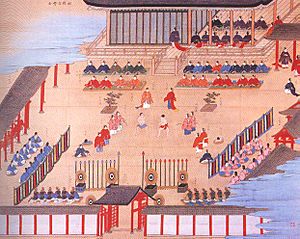Sport in Japan facts for kids

Sports in Japan are a big part of Japanese culture. Japan has many old, traditional sports like sumo, judo, karate, and kendo. There are also sports that came from other countries, such as baseball, soccer, golf, and skiing. Sports are popular with both people who play them and people who watch them.
Contents
History of Sports in Japan
Some traditional Japanese sports, like yabusame (archery on horseback), have been around for a very long time.
During the Meiji period (1868-1912), sports from Western countries became very popular in Japan.
- Baseball was first played at Waseda University in Tokyo in 1890.
- Golf came from England. The first golf course was built in Kobe in 1903.
- Gymnastics was encouraged in schools as early as 1872.

- Rugby teams started at Keiō University in Tokyo in 1899.
- Soccer was first played in 1878.
- Swimming competitions began at the Yokohama Amateur Rowing Club in 1898.
- Tennis became popular in 1878.
- Track and field competitions started in 1883 at the University of Tokyo.
- Volleyball came from the United States in 1914.
- Weightlifting became popular thanks to Jigoro Kano in 1922.
What is Puroresu?
Another popular sport to watch in Japan is professional wrestling, known locally as puroresu (プロレス). This sport was known in Japan before World War II. However, it became very popular in the 1950s with the rise of Rikidōzan, who is called the "father" of puroresu.
While puroresu is similar to professional wrestling in other parts of the world, it has its own unique style. Many matches focus on the wrestlers' "fighting spirit." Also, because many Japanese wrestlers have backgrounds in martial arts, they often make full contact during their moves. Puroresu is also closely connected to mixed martial arts (MMA). Some companies even hold wrestling matches and MMA fights at the same event. Because of this, both wrestlers and fans see puroresu as a serious combat sport.
At first, Western sports were seen as a way to train the mind. But over time, they became fun activities for everyone. Important athletes, sports clubs, and training schools helped spread sports across Japan.
In Japan, sports groups are a big part of school life. Students learn important lessons in these groups. For example, players learn to use keigo (polite speech) and show respect and follow traditions.
Japan and the Olympic Games
Japan was supposed to host the 1940 Summer Olympics and the 1940 Winter Olympics. But the organizers had to cancel in 1938 because of the Second Sino-Japanese War. These games were later completely cancelled because of World War II.
Japan has hosted the Olympic Games three times and will host them a fourth time:
Related Sports
Images for kids
-
Karate practices at Shuri Castle in 1938
-
J1 League football game at Saitama Stadium
-
2006 Olympic Champion Shizuka Arakawa skates at the 2009 Japan Open.
-
Japan in white against Kyrgyzstan in bandy
See also
 In Spanish: Deporte en Japón para niños
In Spanish: Deporte en Japón para niños












